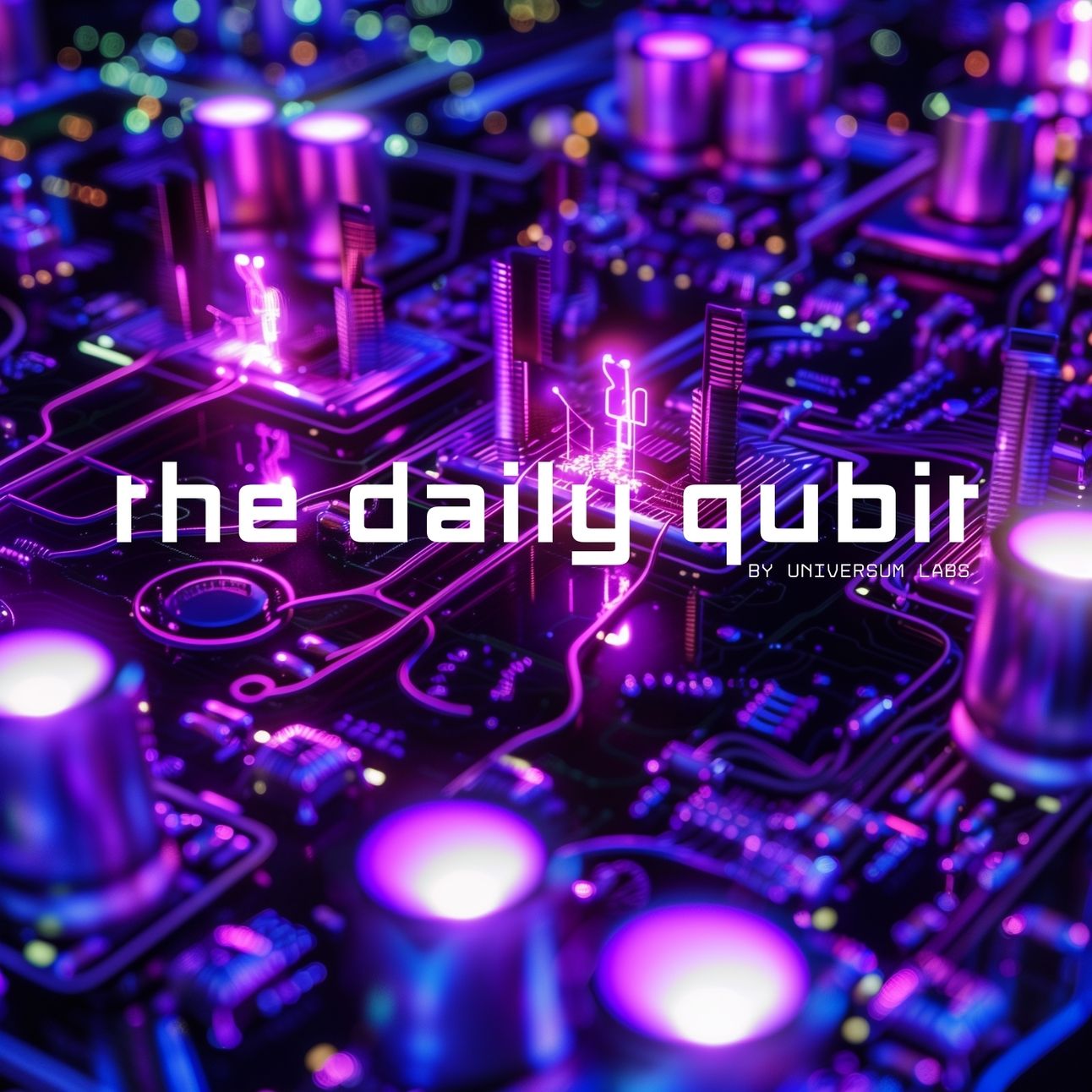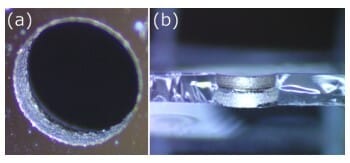- The Daily Qubit
- Posts
- The Daily Qubit
The Daily Qubit
🤖 All your AI newsletters are talking about Nemotron, but at least we've got hybrid quantum solvers, sapphire substrates, and 10K qubits. You know, just a handful.

Welcome to the Quantum Realm.
😿 If it seems like all your cool friends are at the D-Wave Qubits Conference, you’re not wrong. But at least you’ve got the Daily Qubit to read while you cry work. It’s the little things.
🗓️ THIS WEEK
Monday, June 16 - Tuesday June 17 | D-Wave Qubits Conference (Boston, MA & Livestream)
Sunday, June 23 | QTM-X Quantum Education Series 5 of 10: Quantum Hardware
📰 NEWS QUICK BYTES
If you don’t have a primarily quantum network on socials, you may or may not have known that the D-Wave Qubits Conference kicked off this morning leaving many of us with FOMO (that Watermark Hotel is stunning, is it not?). So, while you’re not taking selfies in front of stunning blue gradients of light, you can read up on how
💹 D-Wave users just got an early holiday gift via a newly released hybrid quantum solver for nonlinear programs. The two most important keywords to take from the press release are “hybrid” and “nonlinear”. Hybrid computing is more efficient, more proven, more scalable, less costly, insert more good things here. And yes, you can think of linearity in terms of that high school algebra course: linear = straight lines = easy-to-solve-for function and non-linear means two points don’t correspond to a straight line. So, while D-Wave had already positioned itself as leader of optimization, the additional support for complexity will only expand its reach.
💎 Davidson Technologies is getting the US’s second on-prem D-Wave annealer. Davidson Technologies specializes in providing innovative tech for the Department of Defense, aerospace industry, and various commercial uses. The on-site annealer will possibly one day maybe be used solely by the firm itself, but for now, D-Wave users can rejoice for the additional compute time, a rarity indeed.
🤯 In other quantum giant news, IBM and Japan announce (leak) the release of a 75X more powerful quantum machine, coming to you in just a measly five years. You may remember that back in April, IBM partnered with Japan’s RIKEN to deploy IBM quantum architecture alongside the Fugaku supercomputer (refresher here). Now it surfaces that IBM and Japan’s science institute AIST have some goals of their own, and it’s not at all on the scale of “a nice, perfectly reasonable hybrid deployment.” The duo plans to release a 10,000 qubit quantum computer by 2029. If so, it will surely be a new era. The good news? If you start now, there’s no reason you can’t be a QC expert by that time.
☯️ Experts from institutions such as the University of Pennsylvania, Multiverse Computing, and Accenture weigh in on the future of quantum computing and of efforts to integrate with AI. Consider the potential to speed up LLM-training — while many are being told to leave LLMs to the big players, domain-specific LLMs are undeniably more valuable for niche applications. While skeptics abound, the usual suspects for speedups are reiterated here (materials science, drug development, optimization, and finance) and the expected timeline is always a few years off. Though, Tom Patterson of Accenture comments that the technology will arrive “gradually, and then all at once.” So the inherently psychic sigmoid curve then, as it is with many a natural process.
🔨 Global Quantum Intelligence released an interactive dashboard for members — users can view tech stacks of key players including error correction, control, and quantum hardware specifics. This is especially useful for understanding what modular combinations have been done (and what haven’t, hint hint for anyone out for that VC) and keeping tabs on the state of quantum tech. If you’re a user, revel in your previous good decisions. If you’re not a user but have been toiling away in Excel pages to do the same, you can probably stop.
Today's news is more personalized and less strictly summary.Do we love it? Do we hate it? |
☕️ FRESHLY BREWED RESEARCH
Integration of through-sapphire substrate machining with superconducting quantum processors: Sapphire, while able to support high-coherence qubits, falls victim to low-frequency modes which will become increasingly difficult to manage as QPUs scale. Researchers from Oxford Quantum Circuits find the solution in developing effective machining processes to encourage through-substrate vias and mitigate low-frequency modes. Breakdown here.
Comparing Natural Language Processing and Quantum Natural Processing approaches in text classification tasks: As further quantum and AI integrations are explored, it leaves many to wonder if quantum computing can apply speedups to NLP tasks, key to LLMs. While speedups were observed in simple text classification tasks, viability decreased as complexity increased. Breakdown here.
CS-count-optimal quantum circuits for arbitrary multi-qubit unitaries: Optimal algorithms for the Clifford+CS gate set are presented to show it can implement multi-qubit unitaries with fewer gates than previously established, making it a resource-efficient alternative to the Clifford+T gate set.
Integrating Sustainable Big AI: Quantum Anonymous Semantic Broadcast: Resource consumption and the resulting environmental impact are notable concerns in the increasing use of AI. This paper proposes an AI native framework for semantic communication that combats these challenges by using AI for semantic extraction and quantum anonymous communication protocols for security.
Bias-preserving computation with the bit-flip code: The bit-flip repetition code is analyzed for use in fault-tolerant quantum computation in biased noise channels where only bit-flip errors occur. Simulations demonstrate improved precision in tasks such as time evolution of quantum systems and the execution of the variational quantum eigensolver, all without introducing phase-flip errors.
UNTIL TOMORROW.
BREAKDOWN
Integration of through-sapphire substrate machining with superconducting quantum processors
🔍️ SIGNIFICANCE:
It’s no news that fault tolerance will require that quantum processors increase in size and number of qubits. But, as they do so, managing low-frequency modes on superconducting processors becomes key for maintaining coherence.
Low-frequency modes are unwanted oscillations that happen within the QPU. Since they are at lower frequencies then the qubits, they can interfere and cause decoherence. So, how do you combat that? TSVs are vertical electrical connections that go through the substrate of the QPU. By creating these direct paths for electrical signals, TSVs help to dampen the unwanted oscillations.
Enter sapphire substrates. While known for their low dielectric loss and support for high-coherence qubits, they are limited by their lack of effective through-substrate via processes since they are resistant to most physical and chemical etching processes. This research presents a sapphire machining process for enabling the through-substrate electrical connections.
🧪 METHODOLOGY:
The experimental validation was used on a 32-qubit QPU names “Toshiko”
A computer numerical control machining process is used to create through-sapphire apertures necessary for integrating inductive shunting in QPUs. A diamond micro-grain tool drilled 1mm diameter apertures into the sapphire substrate.
CNC machining in particular was selected over laser drilling to avoid thermal effects and resist cross-linking.
The apertures were machined after the Josephson junctions, but before wafer dicing intentionally to protect against electrostatic damage and debris.
📊 OUTCOMES & OUTLOOK:
The measured coherence times for the QPUs showed values in line with those on silicon substrates and there was minimal increase in Josephson junction resistance spread post-machining.
This confirms that sapphire is a viable candidate for scaling superconducting qubits, plus, there are implications for other low-loss dielectric substrates like sapphire to be used in larger QPUs.
Source: Narendra Acharya and Robert Armstrong and Yashwanth Balaji and Kevin G Crawford and James C Gates and Paul C Gow and Oscar W Kennedy and Renuka Devi Pothuraju and Kowsar Shahbazi and Connor D Shelly. Integration of through-sapphire substrate machining with superconducting quantum processors. arXiv quant-ph. (2024). https://doi.org/10.1103/PRXQuantum.5.020362
BREAKDOWN
Comparing Natural Language Processing and Quantum Natural Processing approaches in text classification tasks
🔍️ SIGNIFICANCE:
Classical NLPs are behind your favorite LLM — but language processing tasks, such as text classification, do not run at lightening speed by any account. This research explores the viability of using quantum NLP to achieve speedups over classical technology.
🧪 METHODOLOGY:
Both classical and quantum methods are used for text classification tasks. DisCoPy and lambeq libraries are used to transform sentences into string diagrams and quantum circuits so natural language tasks can be executed on quantum hardware.
Synthetic datasets were created to train and test the models, including sentiment analysis and name entity recognition tasks.
Sentences were parsed into string diagrams using the BobCat parser, encoded into an ansatz, and trained using a Pytorch model.
Sentences were converted into diagrams using DisCoCat parser, optimized by removing cups and caps, parameterized into quantum circuits using different ansatz, and trained using quantum simulators and real quantum devices provided by IBM.
The models were trained both classically and quantumly and accuracy and training times recorded.
📊 OUTCOMES & OUTLOOK:
In terms of accuracy, quantum simulation achieved higher accuracy compared to the classical models in 2-label classification tasks. However, as the number of labels increased, the accuracy of quantum models decreased.
Quantum models, especially those run on real quantum hardware, required a lot more training time compared to classical models. For instance, training on quantum hardware could take up to 120 hours, while classical models trained in under a minute. In terms of cost, consider that 1 second on Qiskit Runtime is currently $1.60.
While the promise for QNLP is there, it is currently only viable for simpler tasks until we can reduce current quantum hardware limitations.
Source: David Peral-García and Juan Cruz-Benito and Francisco José García-Peñalvo. Comparing Natural Language Processing and Quantum Natural Processing approaches in text classification tasks. Expert Systems with Applications. (2024). https://doi.org/10.1016/j.eswa.2024.124427
Support Science
Waking up before the world to dive into the quantum realm isn't just our job—it's our calling. And we're dreaming big with exclusive content for our community. If our work lights up your day, consider showing some love. Your support unlocks worlds—seen and unseen.
Interested in collaboration or promoting your company, product, job, or event to the quantum computing community? Reach out to us at [email protected]


